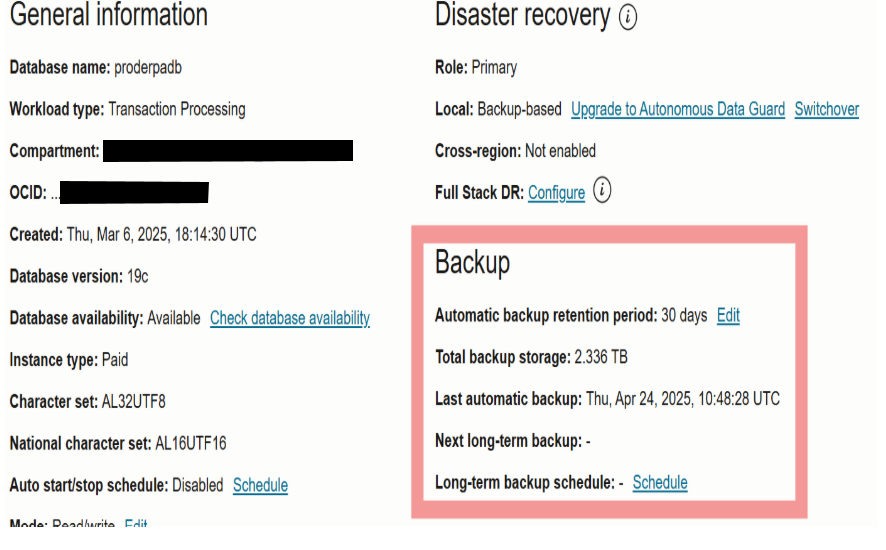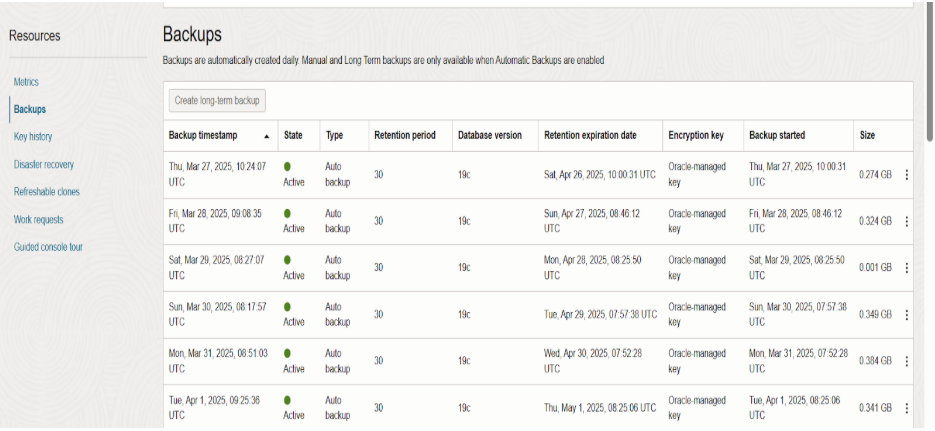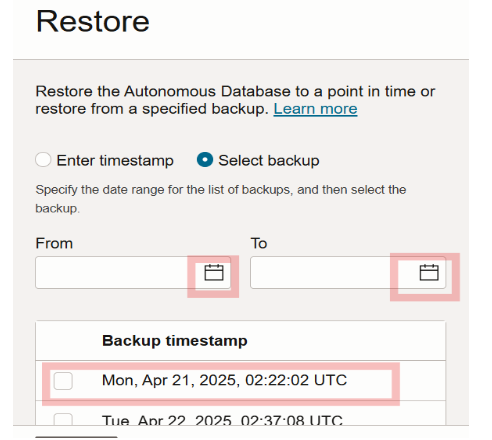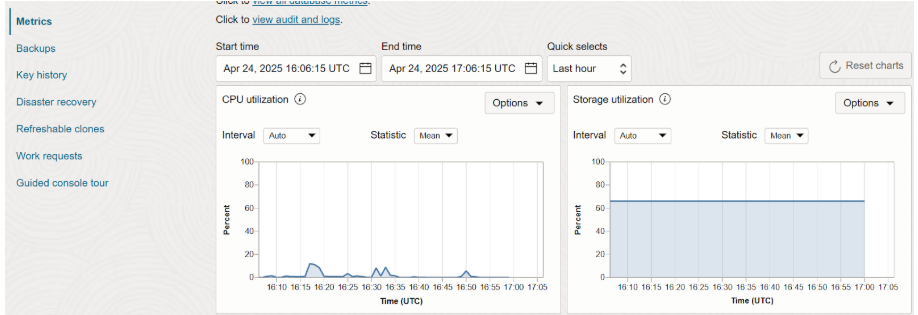OCI Autonomous Database (ADB) – Configuration Document
The Autonomous Database (ADB) on Oracle Cloud Infrastructure (OCI) provides a fully managed database service that automates tasks such as backup, patching, scaling, and performance tuning.
This document outlines the configuration, monitoring, and management procedures for automatic backups of the ADB in the production environment.
Backup details in OCI
The backup system is currently configured with a 30-day retention period and is storing 2.336 TB of data. The last automatic backup completed earlier today at 10:48:28 UTC.
No long-term backup has been scheduled yet, though this option is available through the interface.
Backup Configuration details in OCI
The long-term backup configuration interface allows you to establish an automated backup schedule managed by Oracle. You can set retention periods ranging from 3 months to 10 years, with the current selection set to 365 days (1 year). The system is configured for weekly backups beginning April 24, 2025, at 16:52:40 UTC. Note that long-term backup storage incurs additional charges separate from standard database storage costs, as indicated by the warning message at the bottom of the configuration panel.
Backups Maintained
The following table summarises the different types of backups taken and maintained for the Autonomous Database (ADB) in the production environment:
| Backup type | Description | Frequency | Retention Period |
| Automatic Backups | Point-in-Time Recovery enabled | Every 24 hours | 30 Days |
Automatic Backups:
These backups are retained for 30 days and support Point-in-Time Recovery (PITR) to restore the database to any point within this window. and the backup is taken once every 24 h.
Recent Backup History
The Recent Backup History Table gives you a detailed list of your recent database backups, whether they are automatic, manual, or long-term. It helps DBAs keep track of backup activity and verify that critical data is being protected.
Point-in-Time Recovery
If PITR is enabled, it will let you choose any time within the last 60 days (or custom retention if configured). If you see the PITR calendar, it is enabled.
Backup Storage Location and Cross-Region Backup
-> If ADB is in Region: us-phoenix-1, then the backup is stored in the Object Storage Bucket in us-phoenix-1
-> Autonomous Databases do not support automatic cross-region backup copy.
Restore & Recovery in OCI Autonomous Database
Restore and recovery are processes used to bring back a database to a previous state using available backups.
Restoring in OCI Autonomous DB
Point-in-Time Restore: You can restore the database to a specific date and time, provided automatic backups are enabled. Backups are taken daily, and you can restore within the retention window (default: 60 days). You must select a timestamp within this range.
From a Specific Backup: You can also choose a specific backup listed in the Backup History Table and restore from that.
Security in OCI Autonomous Database
Oracle has security built into every layer of the autonomous database. Below are the major security components:
- Data Encryption
- At Rest: Data is encrypted using Oracle-managed keys or customer-managed keys (via OCI Vault).
- In Transit: Data is encrypted using TLS 1.2+ protocols.
- Encryption is always on and cannot be disabled.
- You can rotate keys regularly via OCI Vault (optional).
2 . Access Control
- IAM (Identity & Access Management) Controls who can access the database and what they can do (create, read, delete, restore, etc.)
- Database Users & Roles Inside the database, standard Oracle user roles and privileges apply.
- IP Whitelisting/VCN Control: You can restrict access using access control lists (ACLs) or private endpoints within a VCN.
- Authentication Options
- OCI Console Users
- Database Users (via SQL Developer)
- Federated Identity: Integrate with Okta.
Compliance in OCI
Oracle Cloud meets several industry standards and compliance frameworks:
GDPR : Data privacy and protection
HIPAA : Healthcare information
SOC 1, SOC 2, SOC 3 : Security and availability
ISO 27001, 27017, 27018 : Information security standards
FedRAMP : For U.S. federal customers
PCI DSS : Payment data protection (for relevant services)
Auditing
- Audit logs are collected and can be reviewed using Oracle Data Safe or exported to OCI Logging.
- Example audit logging with the below screenshot
Monitoring
OCI Monitoring Service:
The OCI Monitoring Service captures metrics and logs for your Autonomous Database. Visualize and analyze them in the OCI Console.
Key Features:
- Resource Monitoring: Track resource utilization like CPU, storage, and memory usage.
- Database Performance Metrics: Monitor database operations, query performance, and connection statistics.
- Custom Metrics: Set up custom metrics for your database based on specific requirements.
- Visual Dashboards: Use the pre-configured dashboards in the console for quick insights into database performance.
This screenshot shows some of the metrics monitoring services
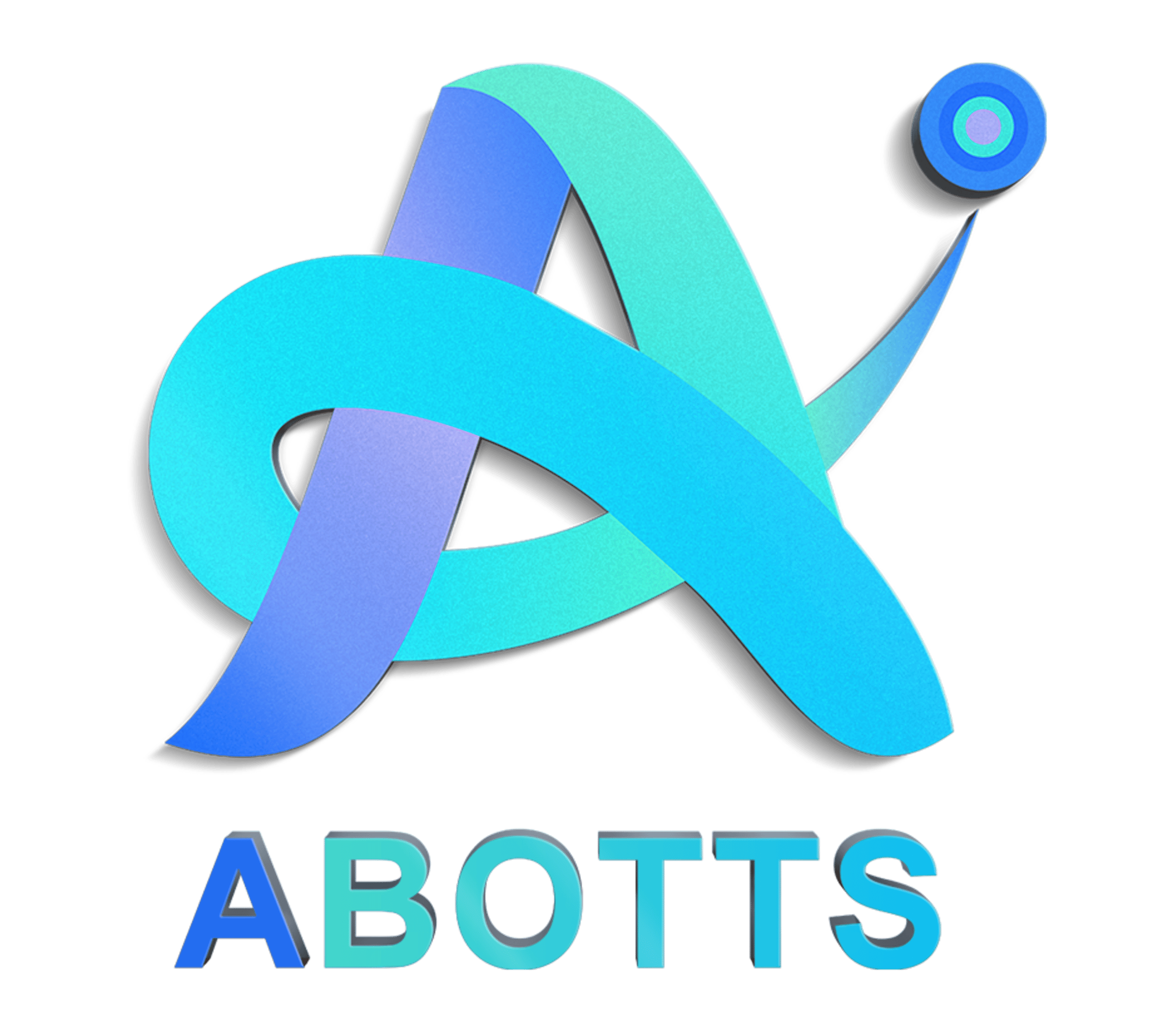
 Abotts Partners with singapore based tech giant to help migrate their public sector customer from Sybase to SQL server.
Abotts Partners with singapore based tech giant to help migrate their public sector customer from Sybase to SQL server.
 Abotts successfully decouples and migrates Upwork EBS custom schema to oracle cloud.
Abotts successfully decouples and migrates Upwork EBS custom schema to oracle cloud.
 QuinStreet partners with Abotts to archive and manage their IT systems on Oracle cloud (OCI).
QuinStreet partners with Abotts to archive and manage their IT systems on Oracle cloud (OCI).
 Abotts Inc Partners with Gnorth consulting to deploy exadata and ODA for a large public sector customer.
Abotts Inc Partners with Gnorth consulting to deploy exadata and ODA for a large public sector customer.
